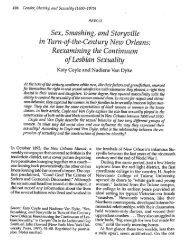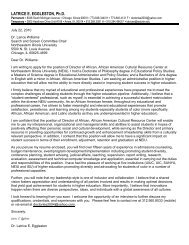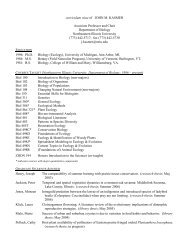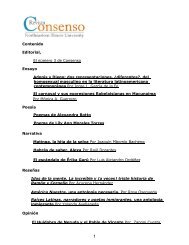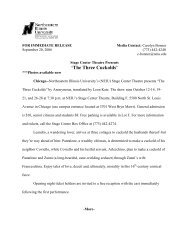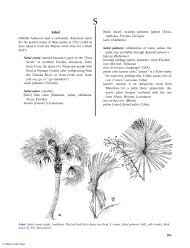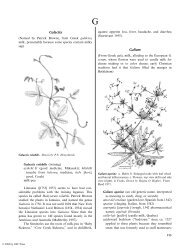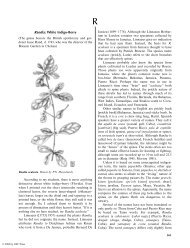Herba Cana - Northeastern Illinois University
Herba Cana - Northeastern Illinois University
Herba Cana - Northeastern Illinois University
You also want an ePaper? Increase the reach of your titles
YUMPU automatically turns print PDFs into web optimized ePapers that Google loves.
© 2004 by CRC Press<br />
540 Florida Ethnobotany<br />
southeastern tribes making their largest canoes of<br />
poplar. Southeastern people also used the wood to<br />
make stools, doors of houses, and fire sticks. Populus<br />
deltoides wood more recently has been used for paper<br />
pulp, cases and crates, tubs and pails, excelsior, veneer<br />
for plywood, musical instruments, dairy and poultry<br />
supplies, laundry appliances, and fuel (Vines 1977).<br />
There are numerous records of ‘‘poplar’’ being<br />
used among indigenous people for a variety of medical<br />
treatments. Many of those references are impossible to<br />
pin to a species. Probably Duke et al. (2002) have made<br />
the best choice by listing them all under the name<br />
‘‘poplar’’ (Populus spp.). Caution is advised, however,<br />
because reports of ‘‘popular’’ include both Liriodendron<br />
and Nyssa. Since the Populus species all contain<br />
salicin, it seems likely that they were used similarly in<br />
medicines.<br />
The Populus deltoides was used by several southeastern<br />
tribes and by some in the northeast. The<br />
Catawba used an infusion of the bark, along with wild<br />
cherry and dogwood to treat expectant mothers (Vogel<br />
1970). The Chickasaw boiled cottonwood and willow<br />
roots to make a drink to treat dysentery and fever<br />
(Swanton 1928a). The Choctaw boiled leaves and bark<br />
to treat wounds and made a combination of stems,<br />
leaves, and bark to cure snakebite (Bushnell 1909).<br />
The Creeks used a decoction of cottonwood to treat<br />
sprains and fractures and a decoction of roots as a<br />
remedy for dropsy (Swanton 1928a, Taylor 1940). The<br />
Delaware combined cottonwood with black haw and<br />
wild plum bark to make a woman’s medicine (Moerman<br />
1998). The Iroquois made a vermifuge of the<br />
plants (Hocking 1997). The Ojibwa used the cottonwood<br />
in two distinct ways. Buds were stewed with bear<br />
fat and used to treat earache, while the cotton from<br />
fruits was used as a absorbent on open sores (Vogel<br />
1970).<br />
Porcher (1863) wrote of P. heterophylla, ‘‘Upon<br />
examining the excrescences caused by an insect in<br />
large numbers on the leaves of the cotton-wood tree<br />
... I find them possessed of great bitterness, and<br />
suggest an examination into their tonic properties.’’<br />
No other indication has been found of others following<br />
this lead. However, Porcher (1863) recommended<br />
using P. deltoides extract as a substitute for quinine in<br />
treating what was called at the time as ‘‘swamp fever,’’<br />
now known as malaria (Hocking 1997).<br />
Early in its history another North American<br />
Populus became confused with tropical Bursera.<br />
Because of that confusion, P. balsamifera became<br />
known as tacamahaca (Vogel 1970, Bremness 1994).<br />
That Aztec name was originally applied to Bursera<br />
(see Bursera: Gumbo Limbo), but the literature on<br />
common names now largely associates it with Populus.<br />
In another oddity, the European P. alba became<br />
official in the U.S. Pharmacopoeia between 1895 and<br />
1936 as a source of salicin, but native North American<br />
species were never listed (Vogel 1970). To fill that gap,<br />
Eclectic physicians recommended several native Populus<br />
(Culbreth 1910, Felter 1922).<br />
Prenanthes<br />
(From Greek prenes, drooping, and anthe, flower)<br />
Prenanthes serpentaria. From Britton and Brown 1898.<br />
Hasenlattiach (hare’s lettuce, German)<br />
lattuga montana (mountain lettuce, Italian)<br />
prenanthé (French)<br />
Prenanthes serpentaria (old name for various<br />
plants used to treat snakebite)<br />
cancer weed<br />
[white] canker weed [cankerweed, canker-root]<br />
(‘‘canker’’ came from Old Northern French<br />
cancre, and appeared in English by about A.D.<br />
1000; the word is cognate with ‘‘cancer’’; historically,<br />
the disease was a malady of the mouth,<br />
perhaps a reference to thrush or Candida infection)<br />
dado’cabodji’bik (milk root, for P. alba, Ojibwa)<br />
DeWitt snakeroot; rattlesnake root; snake-gentian;<br />
snakeweed (names given alluding to use against<br />
snakebite)<br />
drop flower (it is not clear if this English name<br />
gave rise to the genus created by Linnaeus in<br />
1753, or vice versa)<br />
earthgall [gall of the earth] (used since about A.D.<br />
1000 for Centaurium pulchellum, alluding to it<br />
being bitter like bile; later applied to Prenanthes)





